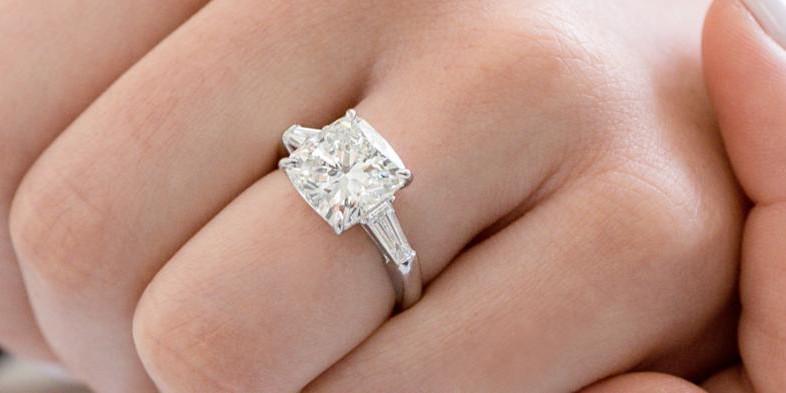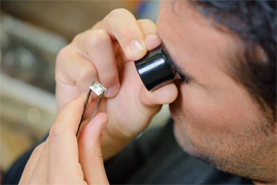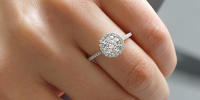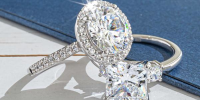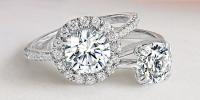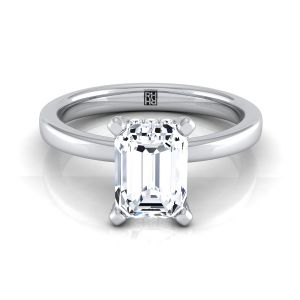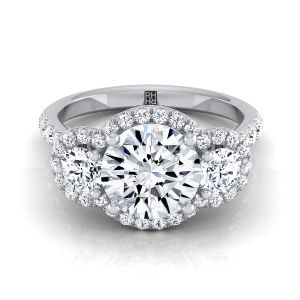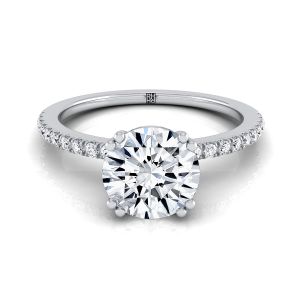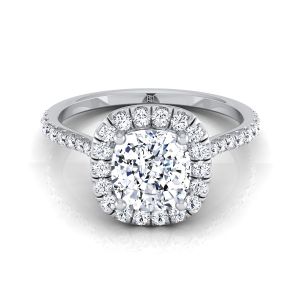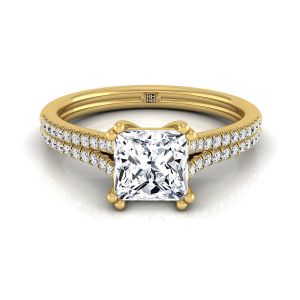Do you know how to take care of that priceless sparkler on your finger? Here are eight essential things you need to know about taking care of your engagement ring.
1. Insure Your Ring
The first thing you should do is to buy insurance for your engagement ring. Because your ring isn’t automatically covered by renters or homeowners insurance, you need to add a specific rider to your existing insurance policy or a separate policy for your ring. To do this, you’ll need an appraisal. (At RockHer, this comes with your ring at no extra charge.)
At RockHer we usually recommend jewelry insurance from Jewelers Mutual because it covers the full replacement of your ring no matter where in the world you lose it. (Some other insurers force you to have a replacement ring made by their vendors and it may not be exactly the quality of the ring you had.) Your policy should be updated every few years to make sure it still covers the value of your ring.
In addition, make sure your engagement comes from a retailer like RockHer that stands behind it with a lifetime warranty and a free resizing.
2. Don't Take Your Ring Off in Public Places
One of the most common ways women lose their engagement rings and wedding bands is by taking the rings off in public restrooms when they wash their hands. There are two reasons this isn't a good idea: your rings can fall into the drain or onto the floor. You can also forget to put your rings back on after you finish washing your hands. Face it: they won't be there when you remember and go back for them. Soap and water won't hurt your rings: keep it on when you wash your hands.
3. Do Take Your Ring Off for Hands-On Activities
Protect your engagement ring by taking it off when doing activities that could damage the metal or gemstones. Working out, rock climbing, sailing, gardening, cooking, and cleaning. When you wash dishes, you can scratch glasses with the diamonds in your ring, so it’s usually not a good idea to wear your ring.
There’s special danger when you wear your engagement ring in the ocean or lake: the cold water shrinks your finger and your ring can slip off into the water. That’s why people lose engagement rings at the beach.
Although many women wear their rings when sleeping, we think it’s better to take them off every night and put them back on when you are ready for the day. Your ring can snag the threads of a blanket or sheet, pulling on and weakening the prongs.
You will probably also want to remove your ring when you’re pregnant, as it will not fit you properly. Resizing your ring to a bigger size temporarily isn’t a good idea: every time you size your ring you weaken the band a little. Wait until after your child is born to see if your ring fits comfortably again without resizing.
Have a designated place where you put your ring so you never misplace it. Ring holders in the kitchen, bathroom, and bedroom mean you never wonder where your ring is.
If you need to remove your ring on the go, slip it onto the chain of a necklace.
| Take off your ring when: |
| • Swimming |
| • Working out |
| • Applying lotions |
| • Cleaning |
| • Sleeping |
4. Clean Your Engagement Ring Every Other Week
Because you wear your engagement ring every day, it needs to be cleaned regularly. Diamonds are oleophilic: they attract oil from your skin which forms a thin film that dims their brilliance. (Interestingly, diamond miners use this property to separate diamonds from gravels: diamonds stick to a greasy surface and ordinary rocks tumble past.)
To keep your diamonds sparkling, clean them every other week or even more often. It’s simple to do this at home. To clean diamond rings, soak them in a bowl with warm water and a few drops of dish soap. (Use a bowl instead of your sink to remove any chance of the ring going down the drain.) Use a soft brush like a clean soft toothbrush (baby sized toothbrushes are especially good since they fit more easily in small spaces.) Pay particular attention to the space behind the setting where dust can collect. Rinse with fresh water and wipe dry with a lint-free microfiber cloth designed for cleaning jewelry, eyeglasses or sunglasses. Don’t dry your rings with paper towels, tissues or soft woven cloths can leave fibers on your ring and can even get caught under the prongs of a setting.
Store-bought non-abrasive jewelry cleaners are a good alternative to brushing. Make sure the cleaner is safe to use on your ring metal, as well as on the diamond itself.
Whenever you are in a jewelry store, you can ask to have your ring professionally cleaned in a large ultrasonic. The jeweler can also inspect your ring to make sure the settings are still secure.
5. Avoid Exposing Your Ring to Chemicals
Chemicals like bleach can discolor precious metals and abrasives like toothpaste, cleanser and baking soda can scratch softer stones and metals. Remove your jewelry before handling any chemicals.
Chlorine in pools and hot tubs can be especially dangerous for your jewelry. Chlorine dissolves metal. If you always wear jewelry in the pool it will gradually wear away.
Lotions like moisturizer, sunscreen, foundation, hair gel, and perfume are chemicals too. Lotions leave residue on your rings that can be difficult to clean and can gradually erode the metal of settings. Lotions can permanently damage porous gems like pearls, turquoise, and coral. Never wear jewelry when applying perfume, lotion, or hairspray.
Never clean your jewelry with bleach, abrasives, baking soda, or toothpaste.
6. Handle your Engagement Ring With Care
There’s a right way and a wrong way to take your ring on and off. When you are sliding off your ring or picking it up to put it on, make sure you always grab it by the band and not the center stone. Over time, grabbing your ring by the setting can bend the metal and make your diamond less secure. It also leaves fingerprints and skin oil on the diamond which dull its brilliance.
7. Give Your Setting Regular Check-ups
Daily wear and tear on your engagement ring adds up over time. Every ring needs some maintenance to stay strong and sparkle on.
Bumps to the ring can shift or loosen stones over time. To make sure that your stones are still secure, tap each stone gently with a fingernail. Stones shouldn’t move at all in their settings. If you find a stone that’s loose, take it to a jeweler to have the prongs tightened. You should also take a very close look at your ring. A prong that’s noticeably shorter than the rest, missing, or bent may mean that your setting is about to break. If any of your stones have shifted or are no longer level they may not be tight enough in the setting to be secure.
White gold rings may yellow over time as the rhodium plating scratches and wears away, revealing the more yellow tone of gold underneath. Your ring can be replated with rhodium to whiten it again.
Your engagement ring will show wear over time: its high polish will gradually fade into more of a satin finish. Daily wear creates tiny scratches on the surface of the metal, giving every ring its own unique patina. If you prefer a high polish, you can have a jeweler restore its shine but this does wear away some of the metal.
8. Store Your Jewelry Separately
To store your wedding rings temporarily at home, put them in the same safe and secure spot every time. Don’t put your jewelry by the sink or within a child’s reach! A ring holder, jewelry box or ring dish is a secure place to temporarily leave your ring.
For longer term storage, put your ring in a fabric pouch or separate compartment in a jewelry box. One of the most common ways jewelry is damaged is being scratched by other jewelry. Due to their natural hardness, diamonds can damage other gemstones, metals, and even other diamonds.
Avoid storing your rings in lockers at the gym or pool or in your beach bag. It’s safer to leave your ring in your car in a fabric pouch or to wear your ring on a necklace if you can’t leave it at home. If you need to stash it when you're on vacation, store it in the hotel safe.
Engagement Ring Care: 10 Dos & Don'ts
| DO | |
| ✔ | Clean your engagement ring regularly |
| ✔ | Remove your ring for hands-on activities |
| ✔ | Insure your ring |
| ✔ | Check gems to make sure they are secure in the setting |
| DON'T | |
| ✗ | Wear rings to the beach |
| ✗ | Take rings off in public places |
| ✗ | Use abrasives to clean your ring |
| ✗ | Expose your ring to chemicals |
| ✗ | Pull on the center stone when taking it off |










